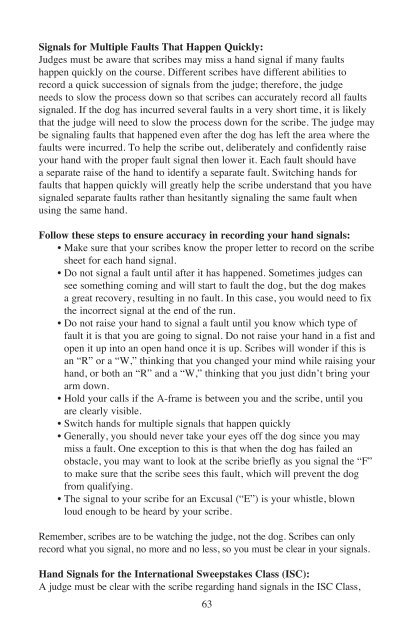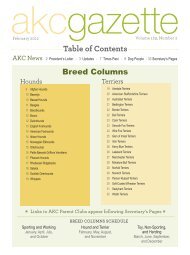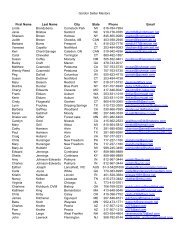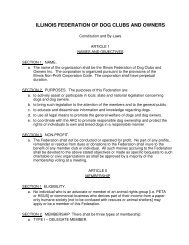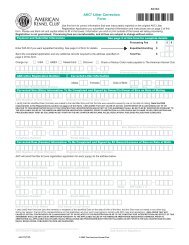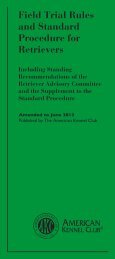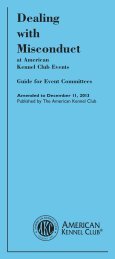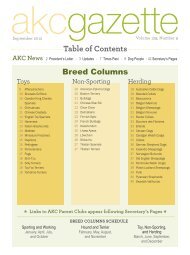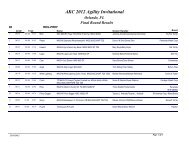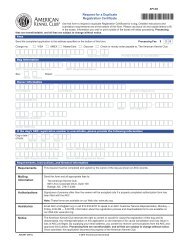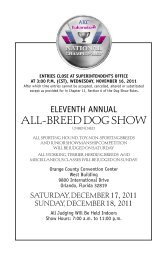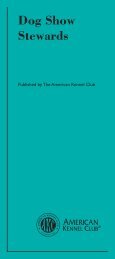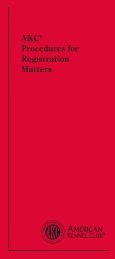You also want an ePaper? Increase the reach of your titles
YUMPU automatically turns print PDFs into web optimized ePapers that Google loves.
Signals for Multiple Faults That Happen Quickly:<br />
<strong>Judges</strong> must be aware that scribes may miss a hand signal if many faults<br />
happen quickly on the course. Different scribes have different abilities to<br />
record a quick succession of signals from the judge; therefore, the judge<br />
needs to slow the process down so that scribes can accurately record all faults<br />
signaled. If the dog has incurred several faults in a very short time, it is likely<br />
that the judge will need to slow the process down for the scribe. The judge may<br />
be signaling faults that happened even after the dog has left the area where the<br />
faults were incurred. To help the scribe out, deliberately and confidently raise<br />
your hand with the proper fault signal then lower it. Each fault should have<br />
a separate raise of the hand to identify a separate fault. Switching hands for<br />
faults that happen quickly will greatly help the scribe understand that you have<br />
signaled separate faults rather than hesitantly signaling the same fault when<br />
using the same hand.<br />
Follow these steps to ensure accuracy in recording your hand signals:<br />
• Make sure that your scribes know the proper letter to record on the scribe<br />
sheet for each hand signal.<br />
• Do not signal a fault until after it has happened. Sometimes judges can<br />
see something coming and will start to fault the dog, but the dog makes<br />
a great recovery, resulting in no fault. In this case, you would need to fix<br />
the incorrect signal at the end of the run.<br />
• Do not raise your hand to signal a fault until you know which type of<br />
fault it is that you are going to signal. Do not raise your hand in a fist and<br />
open it up into an open hand once it is up. Scribes will wonder if this is<br />
an “R” or a “W,” thinking that you changed your mind while raising your<br />
hand, or both an “R” and a “W,” thinking that you just didn’t bring your<br />
arm down.<br />
• Hold your calls if the A-frame is between you and the scribe, until you<br />
are clearly visible.<br />
• Switch hands for multiple signals that happen quickly<br />
• Generally, you should never take your eyes off the dog since you may<br />
miss a fault. One exception to this is that when the dog has failed an<br />
obstacle, you may want to look at the scribe briefly as you signal the “F”<br />
to make sure that the scribe sees this fault, which will prevent the dog<br />
from qualifying.<br />
• The signal to your scribe for an Excusal (“E”) is your whistle, blown<br />
loud enough to be heard by your scribe.<br />
Remember, scribes are to be watching the judge, not the dog. Scribes can only<br />
record what you signal, no more and no less, so you must be clear in your signals.<br />
Hand Signals for the International Sweepstakes Class (ISC):<br />
A judge must be clear with the scribe regarding hand signals in the ISC Class,<br />
63


